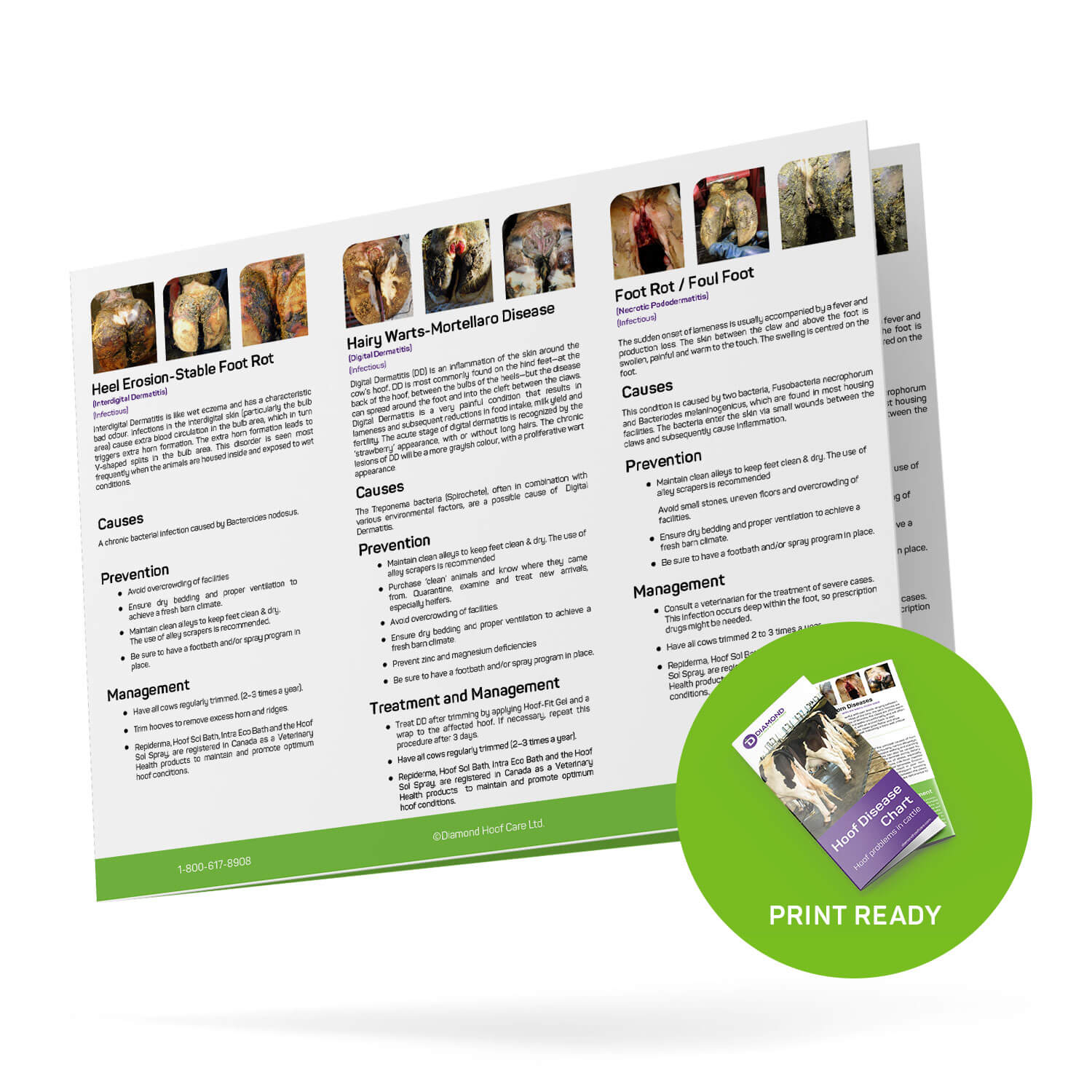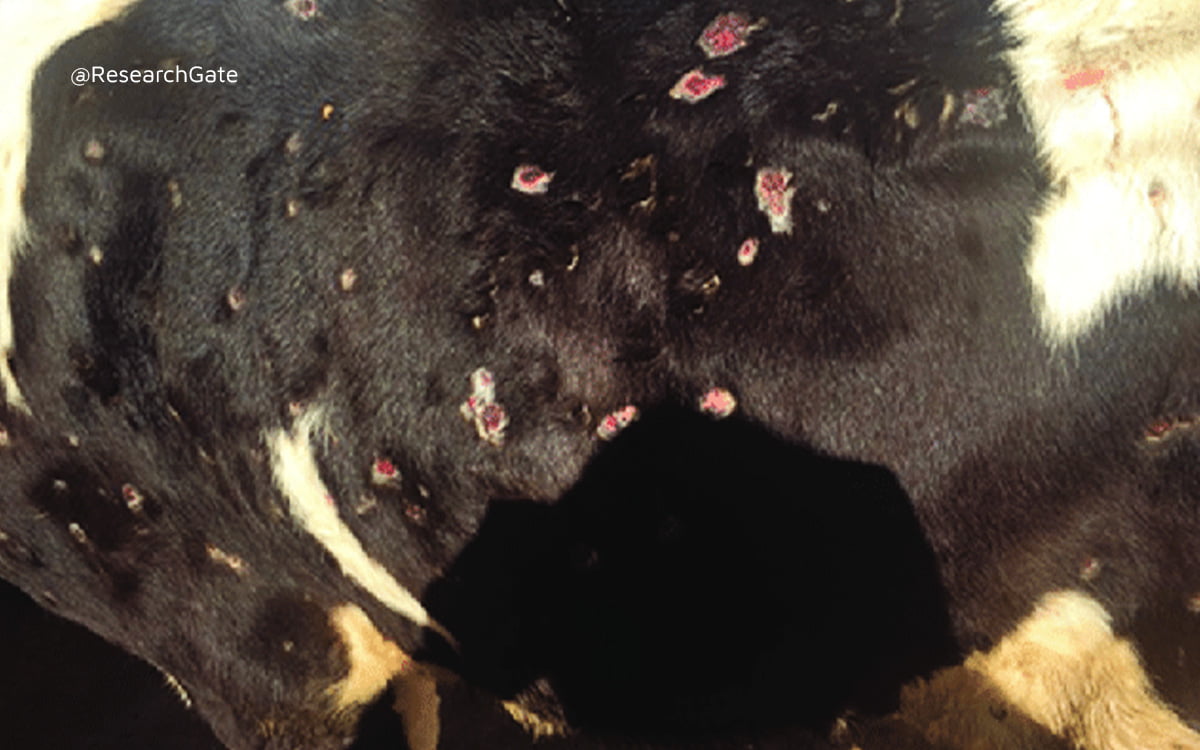What is Digital Dermatitis in cows?
Lameness Control Strategies
We can split our approaches to lameness control into two categories: Preventative care and Curative care. In this overview, I take a look at these two approaches and make some comments about both. Let’s start with the one that seems to be the easiest and gives us the best return.
I have created an easily downloadable hoof disease chart which contains the common hoof disease in cattle. This reference sheet can assist you with the diagnosis of hoof problems.
Preventative Hoof Care
Preventative hoof care is defined as “Methods to avoid the occurrence of disease (lameness).” What this means is that there are no problems present. This scenario occurs in a perfect world, but it’s not what you usually find in your dairy herd. Even in this perfect world, there can still be factors that could, over time, develop into a lameness challenge.
Let’s compare this to milking and mastitis prevention: you provide dry bedding and pre- and post-dipping to the animals to prevent mastitis from occurring. Still, the factors that lead to mastitis are often present: possible genetic predisposition, bacteria in the barn and on the udder, etc. With these factors present, you use all the means available to minimize the chances of problems developing.
In today’s dairy industry, we’ve come to a practical definition of the word “prevention”. This definition is as follows: “Methods to treat an existent problem in its early stages before it causes significant morbidity.” Morbidity refers to the lameness ‘state’ of the cow or the incidence of lameness in the herd setting. This practical definition tends to become a standard, although on a slippery slope. If we want to get the best results and return on our investment, it’s important that we have a proper definition. Let’s draw the comparison again between mastitis treatment and lameness: “once a cow gets mastitis, she receives treatment to cure the problem and get the milk back in the tank ASAP.” Lameness is really no different, is it?
As a herd manager, it’s important that you know your herd’s challenges and weak links and manage your operation accordingly. Examples of areas of Preventative care are:
- Proper hoof trimming
- Prevention foot bathing
- Timely cleaning of the barn floors
- Proper ration and forage management
- Cow comfort: stalls, bedding packs, ventilation, etc.
Curative Hoof Care
Curative hoof care, the second category to our approach to lameness, is defined as: ‘seeking a cure for an existent disease or “condition.” Here, our cow shows signs of a hoof defect: she is either slightly uncomfortable in her gait or moderately lame, or even has a severe limp: all these animals fall into our curative care category. Is it not fair to say – when we notice ‘other-than-normal’ walking behavior – that our preventive care plan has failed or is lacking? At this stage, it’s important to understand and confirm the cause and nature of the improper gait. First, the affected animal should be examined and treated ASAP (just like we do for mastitis), to get the best rate of successful healing. Depending on the hoof problem, of course, a few examples of curative care are:
- A simple hoof trim to balance the claws and apply some trimming techniques to shift weight from the sore claw to the healthy claw.
- Placing a wrap for an infectious problem using the Intra Hoof-fit Gel.
- Gluing a block.

Hoof Disease Reference Chart
Bridging Prevention: Footbaths?

Figure 1. Intra Bath in Use.
Bridging Prevention
One question you might ask is: “Why to bother to spray during milking and what are the real benefits?”
Excellent question! Here are a few benefits:
- Cleaning all hooves is so beneficial in contrast with the footbath method, where the last cow gets the dirtiest solution (she is usually your lame cow).
- A weekly focus allows for finding and detecting new lameness cases promptly; a footbath protocol often lacks this focused approach.
Some herds use a 5-liter Matabi applicator or utilize the teat-dip system for hoof care spraying. We recently met producers who purchased the Intra Spray-fit pump to bridge the gap between preventative and curative care. During the spraying sessions, they compile a list of animals to work on in the hoof-trimming chute.Why should we spray only the rear hooves? Concentrating on them will often suffice because hoof problems are more common in the hind legs.
So, what does a protocol look like? Here’s one example:
- Monday and Tuesday: foot-bathing method
- Wednesday: spraying session and make a list of cows to work on.
- Thursday and Friday: treatment and trimming days (trimming, blocking, gel wrapping, rechecks, etc.) using Hoof-fit Gel.
- Monday morning: removal of all wraps.
- Repeat.
Final Note
As a final note, thank you to the dairy friend who suggested this topic of lameness control strategies. I would like to say that it’s rather difficult to find the right words and overall coverage for this topic. I apologize if I missed anything – perhaps your operation has different challenges. If you want to forward any ideas or suggestions, please send me a message through the Contact page.


